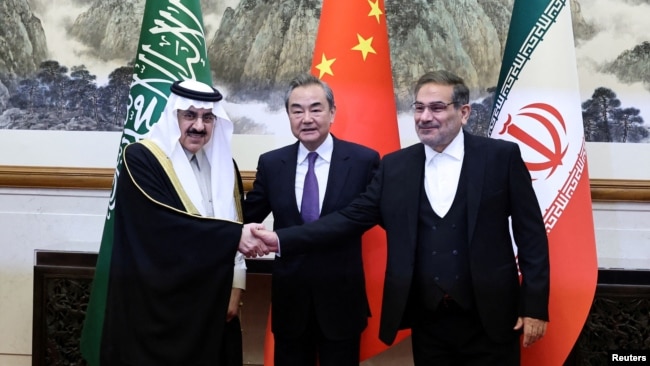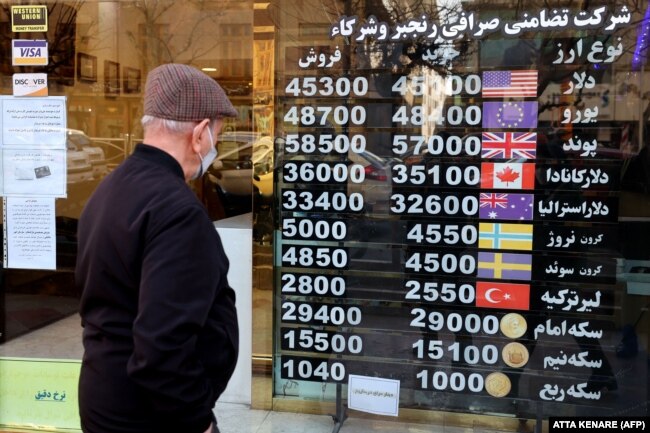
Following the announcement of the March 10 agreement, which came after four days of previously unannounced talks in Beijing, the Wall Street Journal reported that Chinese leader Xi Jinping plans to continue to press ahead with his country’s regional leadership and host ahigh-level meeting of Gulf Arab leaders and Iranian officials in Beijing later this year.
The gathering has reportedly been in discussion since December, when Xi met with Arab leaders at a regional summit in Riyadh and proposed the idea.
The deal between Iran and Saudi Arabia highlights Beijing’s growing focus on the Middle East, where Xi’s long-term foreign policy goal of presenting Chinese leadership as an alternative to the United States is finding fertile ground amid waning American influence and China’s expanding economic and political ties with the region.
Wang Yi, China’s top diplomat, said that the success of the talks between Riyadh and Tehran — whose rivalry has long shaped politics and trade in the region — was attributed to Xi’s leadership and that it was “a victory for peace.”
“China will continue to play a constructive role in handling hot-spot issues in the world and demonstrate its responsibility as a major nation,” said Wang, who represented China in the talks. “The world is not just limited to the Ukraine issue.”
Saudi Arabia cut ties with Iran in 2016, and the diplomatic rapprochement comes as the countries have squared off against each other in regional proxy conflicts over the years. Analysts have cautioned that the China-brokered deal faces obstacles ahead and that it will take more than renewed diplomatic relations to mend ties. But the agreement also reflects growing pragmatism from each side with Tehran looking to salvage its tattered economy and Riyadh eager to calm tensions that have inflamed wars and fueled attacks on Saudi Arabia and its interests across the region.
“Iran is deeply isolated, humiliated by months of protests, and heavily reliant on China strategically [and] economically. This deal lessens its isolation, gains legitimacy for the regime, and strengthens China’s regional influence at the expense of the [United States],” Karim Sadjadpour, senior fellow at the Carnegie Endowment for International Peace, wrote on Twitter following the peace deal.
“Given China’s enormous leverage over Iran and its interest in regional stability, Riyadh likely hopes this deal provides them a Chinese shield against Iranian aggression,” he added.
Cautious Optimism
According to the Wall Street Journal report, the new deal provides two months for Iran and Saudi Arabia to agree on details before reopening their embassies. Once an agreement is reached on those specifics, the countries’ foreign ministers will then meet to finalize it and the purported Middle East summit in China will take place after that announcement.
“The countries of the region share one fate,” Saudi Foreign Minister Prince Faisal bin Farhan Al Saud, tweeted about the deal. “That makes it necessary for us to work together to build models for prosperity and stability.”
Iranian officials also welcomed the agreement, with Iranian Foreign Minister Hossein Amir-Abdollahian saying it was a sign that Tehran’s regional policy was “strongly moving in the right direction” and that the country’s “diplomatic apparatus is actively behind the preparation of more regional steps.”
While many analysts believe that the deal and China’s role in it are being met with caution in Washington, U.S. National Security Council spokesman John Kirby said the United States supports “any effort to deescalate tensions” and that “we think it’s in our own interests,” noting that it could lead to an end of the civil war in Yemen, which has seen the country’s Iran-backed Huthi militants face off against a Saudi-led coalition in a conflict that has led to hundreds of thousands of people killed and created a dire humanitarian situation.
Tehran was motivated to strike a deal as a currency crisis grips Iran, compounding an already devastated economy from U.S. sanctions over its nuclear program and fallout from months-long public protests against the clerical regime’s rule.
Iranian officials are said to be hoping to extract economic benefits from Riyadh for their easing of tensions as well as from China, which maintains significant economic leverage over Tehran.
Iran’s semiofficial Mehr news agency reported that prior to the March 10 announcement, Beijing allowed Iran to access a portion of some $20 billion in Chinese banks that was frozen when the United States left a landmark nuclear deal and reimposed sanctions against Tehran in 2018.
China promised Iran in 2021 to invest a reported $400 billion in the country in exchange for oil and fuel supplies, though Western sanctions against Tehran have prevented Beijing from realizing the terms of the sprawling agreement.

China In Eurasia Briefing: What’s Beijing’s Next Move On Ukraine?
Beijing also has deep economic links to Riyadh as China is Saudi Arabia’s largest trading partner and the kingdom is one of China’s largest oil suppliers.
Those economic ties have been the bedrock of China’s engagement in the Middle East, where Beijing receives more than 40 percent of its crude oil imports and has a growing interest in regional stability.
But the peace deal also reflects China’s shifting approach to the region, which is moving from being centered on trade and investment toward wading into the Middle East’s tense conflicts.
“So far, China has been very cautious…focusing primarily on business without getting too involved militarily in the Middle East. But things could change,” Zhou Bo, a former senior colonel in the People’s Liberation Army, said this month at an international affairs conference in Israel before the deal was announced.
Beijing’s Evolving Role
In addition to its economic ties, China’s growing influence in the Middle East has been its growing appeal as a partner that touts multilateralism and refrains from criticizing human rights records in the region.
Beijing has also capitalized on fallout from events that have hurt Washington’s standing in the region, such as its 2003 invasion of Iraq and wide-ranging war on terror, with China following a strategy to shun Western ideals and U.S. interests when engaging with the Middle East.
“[Beijing’s] real power is steadily catching up to the willpower to undercut U.S. hegemony,” Tuvia Gering, a China expert at the Institute for National Security Studies, wrote in February for the Atlantic Council think tank.
The United States has long-standing ties with Riyadh and is its main security partner, though relations have been strained for many years and soured significantly after the gruesome 2018 killing of Washington Post journalist Jamal Khashoggi by Saudi agents, allegedly at the behest of Saudi Crown Prince Muhammad bin Salman.
While the new peace deal is an early diplomatic coup for China, analysts are also quick to caution about the difficulties ahead for Beijing in navigating one of the most volatile rivalries in the world, which is exacerbated by the Sunni-Shi’a schism.
Reopening embassies and renewing diplomatic relations as outlined in the deal are unlikely to forestall Iran and Saudi Arabia’s struggle for regional dominance.
The war in Yemen will be a critical test for the nascent rapprochement.
Saudi officials are reportedly seeking a way to end the conflict but hammering out a peace agreement will be an even larger task and could reinvigorate tensions between Tehran and Riyadh.
Others have noted that Iran’s Islamic Revolutionary Guards Corps — the hard-line faction that has made armed influence in the Middle East a key policy pillar — has yet to weigh in on the March 10 deal and that it won’t survive without some form of blessing from it.
“It’s one thing for China to host the talks, but it is another for China to help implement the signed agreement on time,” Fan Hongda, a professor at the Middle East Studies Institute of Shanghai International Studies University, wrote after the deal was announced. “What kind of guarantees will China provide if one of the parties does not respect the agreement?





